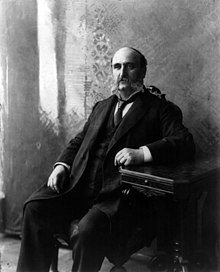Ira D. Sankey
| Ira David Sankey | |
|---|---|
 |
|
| Born |
August 28, 1840 Edinburg, Lawrence County, Pennsylvania |
| Died | August 13, 1908 (aged 67) Brooklyn, New York |
| Occupation | Gospel singer and composer |
| Spouse(s) | Fanny Victoria Edwards (1838–1910), m. 1863–1908; his death |
| Children | John E. Sankey (1868–1912) Ira Allan Sankey |
| Parent(s) |
David Sankey Mary Leepe |
Ira David Sankey (August 28, 1840 – August 13, 1908), known as The Sweet Singer of Methodism, was an American gospel singer and composer, associated with evangelist Dwight L. Moody.
He was born on August 28, 1840 in Edinburg, Pennsylvania, just outside New Castle to David Sankey and Mary (née Leeper).
Aged 16, Sankey was converted at a revival meeting at the King's Chapel (now a United Methodist Church), three miles away from his home. He served in the Civil War as a young man, later taking employment at the Internal Revenue Service, and also the YMCA. He married Fanny Victoria Edwards, one of his choir members, in September 1863; the couple had sons, John Sankey (1868–1912), and Ira Allan Sankey.
Sankey's increasing fame as a Gospel singer eventually attracted the attention of noted evangelist Dwight L. Moody. They first met at a YMCA convention in Indianapolis, Indiana, in June, 1870. Several months later, Sankey attended his first evangelistic meeting with Moody. Shortly thereafter, Sankey resigned his government position.
In October 1871, Sankey and Moody were in the middle of a revival meeting when the Great Chicago Fire broke out. The two men barely escaped the conflagration with their lives. Sankey ended up watching the city burn from a rowboat far out on Lake Michigan. On June 7, 1872, Sankey and Moody made the first of several joint visits to the UK. Sankey's hymns were promoted by London Baptist preacher, Charles Spurgeon, long afterwards. While in Edinburgh, they raised £10,000 at a fundraiser to build a new home for the Carrubbers Close Mission, and the foundation was laid during their time in Edinburgh. Today, the building remains one of the few on the Royal Mile still serving its original purpose.
...
Wikipedia
